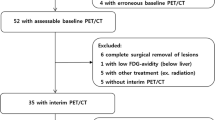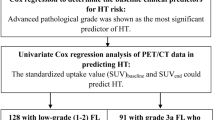Abstract
The objective of present study is to assess the role of the [18Fluorine] 2-Fluoro-2-Deoxy-D-Glucose Positron-Emission-Tomography Computed-Tomography (18F-FDG PET/CT) scan to detect the bone marrow involvement, predict disease free interval (DFI) and histopathological Transformation (HT) in Follicular Lymphoma (FL). Sixty patients were evaluated. Staging 18F-FDG PET/CT scan showed poor sensitivity for bone marrow involvement. Thus, staging 18F-FDG PET/CT cannot replace initial bone marrow biopsy in FL. Maximum standardized uptake value (SUVmax) of lymphomatous lesions in staging 18F-FDG PET/CT scan has no correlation with DFI and HT. Treatment response based on 5-point Deauville Score (5PDS) of interim 18F-FDG PET/CT scan is significantly associated with DFI. Interim 18F-FDG PET/CT scan plays an important role in deciding treatment modification in FL to prevent future recurrence.




Similar content being viewed by others
References
Freedman A (2018) Follicular lymphoma: 2018 update on diagnosis and management. Am J Hematol 93(2):296–305. https://doi.org/10.1002/ajh.24937
Smith A et al (2015) Lymphoma incidence, survival and prevalence 2004–2014: Sub-type analyses from the UK’s Haematological Malignancy Research Network. Br J Cancer 112(9):1575–1584. https://doi.org/10.1038/bjc.2015.94
Ganguly S, Biswas B, Gosh J, Dabkara D (2018) Efficacy and tolerability of bortezomib and dexamethasone in newly diagnosed multiple myeloma. South Asian J cancer 7(2):171–174. https://doi.org/10.4103/sajc.sajc
Szumera-Ciećkiewicz A et al (2020) Population-based epidemiological data of follicular lymphoma in Poland: 15 years of observation. Sci Rep 10(1):1–8. https://doi.org/10.1038/s41598-020-71579-6
Tan D et al (2013) Improvements in observed and relative survival in follicular grade 1–2 lymphoma during 4 decades: the Stanford University experience. Blood 122(6):981–987. https://doi.org/10.1182/blood-2013-03-491514
Perry C et al (2016) The value of PET/CT in detecting bone marrow involvement in patients with follicular lymphoma. Med (United States) 95(9):1–7. https://doi.org/10.1097/MD.0000000000002910
Lossos IS, Gascoyne RD (2011) Transformation of follicular lymphoma. Best Pract Res Clin Haematol 24(2):147–163. https://doi.org/10.1016/j.beha.2011.02.006
Boo SH et al (2019) Predictive value of interim and end-of-therapy 18F-FDG PET/CT in patients with follicular lymphoma. Nucl Med Mol Imaging 53(4):263–269. https://doi.org/10.1007/s13139-019-00602-0
Xie M et al (2021) Significance of initial, interim and end-of-therapy 18F-FDG PET/CT for predicting transformation risk in follicular lymphoma. Cancer Cell Int. https://doi.org/10.1186/s12935-021-02094-5
Giné E et al (2006) The Follicular Lymphoma International Prognostic Index (FLIPI) and the histological subtype are the most important factors to predict histological transformation in follicular lymphoma. Ann Oncol 17(10):1539–1545. https://doi.org/10.1093/annonc/mdl162
Yadav C et al (2016) Serum lactate dehydrogenase in non-Hodgkin’s lymphoma: a prognostic indicator. Indian J Clin Biochem 31(2):240–242. https://doi.org/10.1007/s12291-015-0511-3
Abdel-Sattar MH, Abdelaziz O, Othman AO, El-Refaei SM (2018) The use of Deauville criteria in follow-up assessment of response to therapy in extra-nodal Non-Hodgkin’s lymphoma. Egypt J Radiol Nucl Med 49(1):209–215. https://doi.org/10.1016/j.ejrnm.2017.10.010
Jing Y et al (2023) FDG-PET/CT provides clues on bone marrow involvement in follicular lymphoma and carries important prognostic information. J Cancer 14(14):2726–2738. https://doi.org/10.7150/jca.87523
Author information
Authors and Affiliations
Corresponding author
Ethics declarations
Conflict of interest
The authors express no conflicts of interest in relation to present study.
Additional information
Publisher's Note
Springer Nature remains neutral with regard to jurisdictional claims in published maps and institutional affiliations.
Rights and permissions
Springer Nature or its licensor (e.g. a society or other partner) holds exclusive rights to this article under a publishing agreement with the author(s) or other rightsholder(s); author self-archiving of the accepted manuscript version of this article is solely governed by the terms of such publishing agreement and applicable law.
About this article
Cite this article
Das, S., Gupta, R., Das, J. et al. Role of 18F-FDG PET/CT for predicting bone marrow involvement, disease relapse and histopathological transformation in follicular lymphoma—a single centre observation. J Radioanal Nucl Chem 333, 1627–1632 (2024). https://doi.org/10.1007/s10967-024-09359-z
Received:
Accepted:
Published:
Issue Date:
DOI: https://doi.org/10.1007/s10967-024-09359-z




